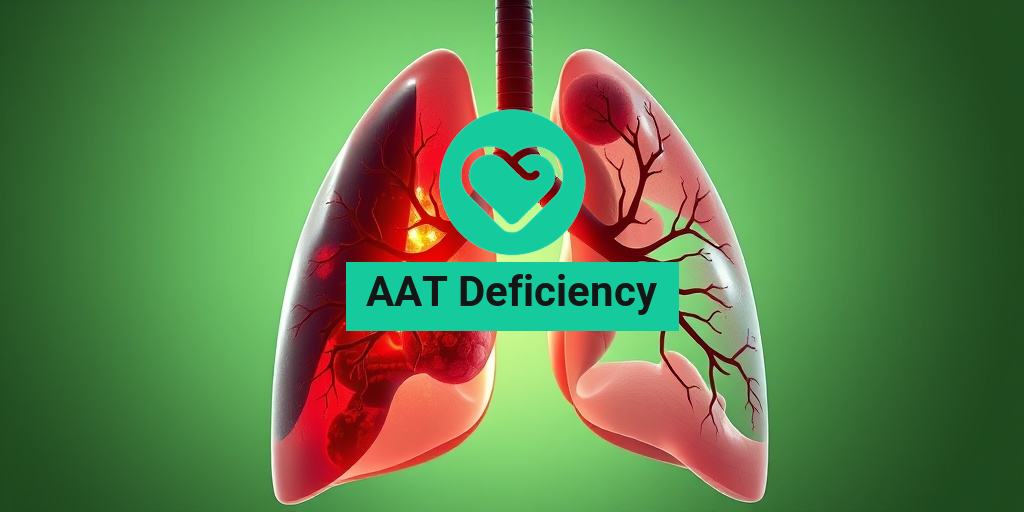What Is AAT Deficiency?
AAT Deficiency, or Alpha-1 Antitrypsin Deficiency, is a genetic disorder that results in low levels of a protein called alpha-1 antitrypsin (AAT) in the blood. This protein is crucial for protecting the lungs and liver from damage caused by enzymes released by inflammatory cells. When AAT levels are insufficient, it can lead to serious health issues, particularly affecting the lungs and liver.
The meaning of AAT Deficiency lies in its genetic inheritance. It is an autosomal co-dominant disorder, meaning that a person can inherit the condition from one or both parents. Individuals who inherit two abnormal genes (one from each parent) are at a higher risk of developing related health problems. Those with one abnormal gene may be carriers and might not show symptoms but can still pass the gene to their offspring.
Understanding AAT Deficiency is essential for early diagnosis and management. The condition is often underdiagnosed, as many people may not exhibit symptoms until later in life. If you suspect you or a loved one may have this condition, consulting a healthcare professional for an AAT deficiency test is crucial.
AAT Deficiency Symptoms
The symptoms of AAT Deficiency can vary widely among individuals, and some may not experience any symptoms at all. However, common symptoms often manifest in the lungs and liver, leading to significant health challenges. Here are some of the most prevalent symptoms associated with AAT Deficiency:
Respiratory Symptoms
- Shortness of breath: Individuals may experience difficulty breathing, especially during physical activities.
- Chronic cough: A persistent cough that may produce mucus can be a sign of lung damage.
- Frequent respiratory infections: Those with AAT Deficiency are more susceptible to infections like pneumonia and bronchitis.
- Wheezing: This may occur due to narrowed airways, making it hard to breathe.
Liver Symptoms
- Jaundice: A yellowing of the skin and eyes can indicate liver dysfunction.
- Fatigue: Chronic tiredness may be a result of liver issues.
- Swelling in the abdomen: This can occur due to liver enlargement or fluid accumulation.
- Easy bruising: A deficiency in clotting factors can lead to increased bruising.
Other Symptoms
In addition to respiratory and liver-related symptoms, individuals with AAT Deficiency may also experience:
- Skin problems: Some may develop a condition called panniculitis, which causes painful lumps under the skin.
- Joint pain: Inflammation can lead to discomfort in the joints.
Recognizing these symptoms early can lead to timely intervention and management. If you or someone you know is experiencing these signs, it’s essential to seek medical advice. A healthcare provider can recommend appropriate tests, including a blood test to measure AAT levels, to confirm a diagnosis.
For more information on AAT Deficiency and its management, consider visiting Yesil Health AI, a valuable resource for evidence-based health answers. Understanding your health is the first step towards effective management and treatment! 🌟

AAT Deficiency Causes
AAT deficiency, or Alpha-1 Antitrypsin deficiency, is a genetic disorder that results in low levels of a protein called alpha-1 antitrypsin (AAT) in the blood. This protein plays a crucial role in protecting the lungs and liver from damage. Understanding the causes of AAT deficiency is essential for early diagnosis and effective management.
Genetic Factors
The primary cause of AAT deficiency is a mutation in the SERPINA1 gene, which is responsible for producing the AAT protein. This mutation can lead to the production of an abnormal form of the protein, which may not function properly or may be misfolded, causing it to accumulate in the liver instead of being released into the bloodstream. The most common genetic variants associated with AAT deficiency are:
- ZZ genotype: This is the most severe form, leading to significantly reduced AAT levels.
- SZ genotype: Individuals with this genotype have moderate AAT levels and may experience milder symptoms.
- MZ genotype: This variant typically results in normal AAT levels, but carriers may still be at risk for lung and liver issues.
Environmental Factors
While AAT deficiency is primarily genetic, certain environmental factors can exacerbate the condition. For instance, exposure to pollutants, cigarette smoke, and occupational hazards can increase the risk of lung damage in individuals with AAT deficiency. These factors can lead to conditions such as chronic obstructive pulmonary disease (COPD) and liver disease, making it crucial for individuals with AAT deficiency to minimize exposure to harmful substances.
AAT Deficiency Risk Factors
Identifying the risk factors associated with AAT deficiency can help in early detection and management of the condition. Here are some key risk factors to consider:
Family History
AAT deficiency is inherited in an autosomal co-dominant manner, meaning that a child can inherit the condition from one or both parents. If there is a family history of AAT deficiency, individuals may be at a higher risk of developing the condition. Genetic testing can help determine if someone is a carrier or affected by the deficiency.
Age and Gender
While AAT deficiency can affect individuals of any age, symptoms often manifest in adulthood. Men may be at a slightly higher risk of developing lung-related complications compared to women, although both genders can experience liver issues. Early diagnosis is crucial, as symptoms may not appear until later in life.
Smoking and Lung Health
Smoking is a significant risk factor for individuals with AAT deficiency. The combination of low AAT levels and exposure to tobacco smoke can lead to accelerated lung damage and increase the likelihood of developing COPD. Quitting smoking and avoiding secondhand smoke are vital steps for those with AAT deficiency to protect their lung health.
Other Health Conditions
Individuals with AAT deficiency may also be at risk for other health conditions, such as:
- Liver disease: AAT deficiency can lead to liver damage, cirrhosis, and even liver failure.
- Respiratory infections: Lower AAT levels can compromise the immune response, making individuals more susceptible to infections.
Understanding these risk factors can empower individuals to take proactive steps in managing their health. Regular check-ups and discussions with healthcare providers can lead to early intervention and better outcomes for those affected by AAT deficiency. 🌟

AAT Deficiency Diagnosis
AAT deficiency, or Alpha-1 Antitrypsin Deficiency, is a genetic condition that can lead to serious health issues, particularly affecting the lungs and liver. Diagnosing this condition is crucial for managing symptoms and preventing complications. Here’s a closer look at how AAT deficiency is diagnosed.
Understanding the AAT Deficiency Test
The primary method for diagnosing AAT deficiency is through a blood test. This test measures the level of alpha-1 antitrypsin in the blood. A low level of this protein can indicate a deficiency. Here’s what you can expect during the testing process:
- Consultation: Your healthcare provider will discuss your symptoms and family history.
- Blood Sample: A small sample of blood will be drawn, usually from your arm.
- Laboratory Analysis: The sample is sent to a lab where it is analyzed for AAT levels.
Symptoms That May Prompt Testing
Many individuals with AAT deficiency may not experience symptoms until later in life. However, certain signs can prompt your doctor to recommend testing:
- Respiratory Issues: Frequent shortness of breath, wheezing, or chronic cough.
- Liver Problems: Symptoms like jaundice, fatigue, or swelling in the abdomen.
- Family History: A family history of liver disease or lung conditions may increase the likelihood of testing.
Genetic Testing for AAT Deficiency
In some cases, genetic testing may be recommended to confirm the diagnosis. This test looks for mutations in the SERPINA1 gene, which is responsible for producing alpha-1 antitrypsin. Understanding your genetic makeup can provide valuable insights into your condition and help guide treatment options.
AAT Deficiency Treatment Options
While there is currently no cure for AAT deficiency, various treatment options can help manage symptoms and improve quality of life. The choice of treatment often depends on the severity of the deficiency and the presence of related health issues.
Medications and Therapies
Several medications and therapies can be beneficial for individuals with AAT deficiency:
- Augmentation Therapy: This involves regular infusions of AAT protein derived from human plasma. It can help increase AAT levels in the blood and may slow the progression of lung disease.
- Bronchodilators: These medications can help open airways and make breathing easier for those experiencing respiratory issues.
- Corticosteroids: In some cases, corticosteroids may be prescribed to reduce inflammation in the lungs.
Liver Management
For individuals experiencing liver complications due to AAT deficiency, management strategies may include:
- Regular Monitoring: Routine check-ups and liver function tests to monitor liver health.
- Healthy Lifestyle: Maintaining a balanced diet, avoiding alcohol, and engaging in regular exercise can support liver function.
- Liver Transplant: In severe cases of liver disease, a liver transplant may be necessary.
Supportive Care and Lifestyle Changes
In addition to medical treatments, making certain lifestyle changes can significantly improve the quality of life for those with AAT deficiency:
- Quit Smoking: If you smoke, quitting is one of the most important steps you can take to protect your lungs.
- Vaccinations: Staying up-to-date on vaccinations, especially for flu and pneumonia, can help prevent respiratory infections.
- Regular Exercise: Engaging in physical activity can enhance lung function and overall health.
Understanding AAT deficiency and its treatment options is essential for managing this condition effectively. By working closely with healthcare providers, individuals can develop a personalized treatment plan that addresses their unique needs and helps maintain a healthy lifestyle. 🌟

AAT Deficiency Management
AAT deficiency, or Alpha-1 Antitrypsin deficiency, is a genetic condition that can lead to serious health issues, particularly affecting the lungs and liver. Managing this condition effectively is crucial for maintaining a good quality of life. Here, we’ll explore various aspects of AAT deficiency management, including lifestyle changes, medical treatments, and monitoring strategies.
Lifestyle Changes
Making certain lifestyle adjustments can significantly impact the management of AAT deficiency. Here are some key changes to consider:
- Quit Smoking: If you smoke, quitting is one of the most important steps you can take. Smoking can exacerbate lung damage and increase the risk of developing chronic obstructive pulmonary disease (COPD).
- Avoid Secondhand Smoke: Even if you don’t smoke, exposure to secondhand smoke can be harmful. Try to stay away from environments where smoking is prevalent.
- Healthy Diet: A balanced diet rich in fruits, vegetables, whole grains, and lean proteins can support overall health. Foods high in antioxidants may help reduce inflammation.
- Regular Exercise: Engaging in regular physical activity can improve lung function and overall well-being. Consult with your healthcare provider to create a suitable exercise plan.
Medical Treatments
In addition to lifestyle changes, there are medical treatments available for managing AAT deficiency:
- Augmentation Therapy: This treatment involves infusing AAT protein derived from human plasma to increase levels in the bloodstream. It can help protect the lungs from damage.
- Medications: Depending on symptoms, your doctor may prescribe bronchodilators or corticosteroids to help manage respiratory issues.
- Liver Monitoring: Regular check-ups and liver function tests are essential for those with liver involvement. In severe cases, a liver transplant may be necessary.
Monitoring and Support
Regular monitoring is vital for individuals with AAT deficiency. Here are some strategies:
- Regular Check-Ups: Schedule routine appointments with your healthcare provider to monitor lung and liver function.
- Genetic Counseling: If you have AAT deficiency, consider genetic counseling to understand the implications for family members and potential inheritance patterns.
- Support Groups: Connecting with others who have AAT deficiency can provide emotional support and valuable information about managing the condition.
AAT Deficiency Outlook and Prognosis
The outlook for individuals with AAT deficiency can vary widely based on several factors, including the severity of the deficiency, age of diagnosis, and the presence of related health issues. Understanding the prognosis can help patients and families prepare for the future.
Factors Influencing Prognosis
Several factors can influence the prognosis of AAT deficiency:
- Severity of Deficiency: Individuals with a more severe deficiency (such as those with the ZZ genotype) are at a higher risk for developing lung and liver diseases.
- Age of Diagnosis: Early diagnosis and intervention can lead to better outcomes. Those diagnosed in childhood may have a different trajectory compared to those diagnosed in adulthood.
- Comorbid Conditions: The presence of other health issues, such as COPD or liver disease, can complicate the prognosis and management of AAT deficiency.
Long-Term Outlook
With appropriate management, many individuals with AAT deficiency can lead fulfilling lives. Here are some key points regarding long-term outlook:
- Quality of Life: Many patients report a good quality of life with proper management and lifestyle changes.
- Life Expectancy: While AAT deficiency can lead to serious health complications, advancements in treatment and management strategies have improved life expectancy for many individuals.
- Regular Monitoring: Ongoing monitoring and proactive management can help mitigate risks and address complications early.
In conclusion, understanding and managing AAT deficiency is essential for maintaining health and well-being. By making informed lifestyle choices, seeking appropriate medical treatments, and staying vigilant with monitoring, individuals can navigate this condition more effectively. 🌟

Frequently Asked Questions about AAT Deficiency
What is AAT Deficiency?
AAT Deficiency refers to a genetic condition where the body does not produce enough of the protein alpha-1 antitrypsin (AAT). This protein is crucial for protecting the lungs and liver from damage. Without sufficient levels of AAT, individuals may experience various health issues, particularly related to the respiratory and hepatic systems.
What are the symptoms of AAT Deficiency?
Common AAT deficiency symptoms include:
- Shortness of breath
- Chronic cough
- Frequent respiratory infections
- Fatigue
- Jaundice (yellowing of the skin and eyes)
- Swelling in the abdomen
If you experience any of these symptoms, it is important to consult a healthcare professional for further evaluation.
How is AAT Deficiency diagnosed?
The diagnosis of AAT deficiency typically involves a AAT deficiency test, which measures the level of AAT in the blood. Additional tests may include genetic testing to identify specific mutations associated with the condition.
What treatments are available for AAT Deficiency?
Treatment options for AAT deficiency may vary based on the severity of the condition and associated symptoms. Common treatments include:
- Augmentation therapy to increase AAT levels
- Medications to manage symptoms, such as bronchodilators for respiratory issues
- Liver transplant in severe cases of liver disease
It is essential to work closely with a healthcare provider to determine the best treatment plan.
Is there a link between AAT Deficiency and COPD?
Yes, individuals with AAT deficiency are at a higher risk of developing chronic obstructive pulmonary disease (COPD). The lack of AAT can lead to lung damage, which may contribute to the development of COPD over time.
What does AAT Deficiency mean for inheritance?
AAT deficiency inheritance follows an autosomal co-dominant pattern. This means that a child can inherit the condition if both parents carry the gene for AAT deficiency. Genetic counseling is recommended for families with a history of the condition.
Can someone be a carrier of AAT Deficiency?
Yes, individuals can be AAT deficiency carriers without showing symptoms. Carriers have one normal gene and one mutated gene, which may not significantly affect their health but can be passed on to their children.
How can I get tested for AAT Deficiency?
A AAT deficiency blood test can be performed by a healthcare provider. This test measures the level of AAT in your blood and can help determine if you have a deficiency.
Where can I find more information about AAT Deficiency?
For more information, consider consulting healthcare professionals or reputable medical websites that specialize in genetic disorders and respiratory health. 🩺




